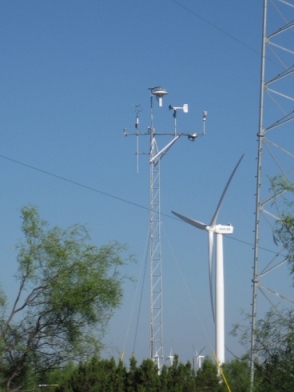ARL has entered into a three-year Cooperative Research and Development Agreement (CRADA) with Duke Energy Generation Services, Inc, a leader in research and development of optimizing alternative energy production through wind generation. The CRADA represents a public/private partnership with the intent of coupling one another’s research goals towards improving the ability of the renewable energy industry to accurately forecast winds at the height of the turbine blades. ARL is using Duke Energy’s Ocotillo Wind Farm, located in western Texas, to collect surface-based, energy-balance observations. ARL has installed two meteorological monitoring systems, a 30-meter high tower instrumented to measure winds and temperature at 5 different heights and a 10-meter high tower to measure energy balance, such as the exchange of heat, momentum, and water vapor at the surface. The data collected will be used to evaluate the different techniques used by ARL and by Duke Energy.
Background: The CRADA was an outcome of issues raised at the 2009 American Meteorological Societies’ summer meeting, which addressed renewable energy. ARL has a long history of research capabilities focused on low level winds and turbulence in the planetary boundary layer (the portion of the atmosphere closest to and most influenced by the Earth’s surface). The wind power industry needs reliable short-term (2-24 hour) weather forecasts at the turbine blade height (typically centered around 50-80 meters) in order to support their requirements for safety, turbine performance, day-to-day operations, and energy grid balance. The goal of this CRADA is to explore the potential for improvements in forecast model performance.
Significance Wind energy has become an important alternative energy option for the Nation’s power grid. Weather forecast uncertainties, however, can have a significant economic impact on wind power production and profitability. For instance, unexpected significant decreases or increases in wind speed can jeopardize stability of the power grid. As a result, utilities maintain extra reserve generation capacity that can respond quickly to changes in wind energy production. However, the cost of this reserve capacity makes it more difficult to utilize wind energy economically. In order to plan effectively, power energy managers require accurate estimates of power generation, and these estimates require accurate forecasts of near-surface winds.


